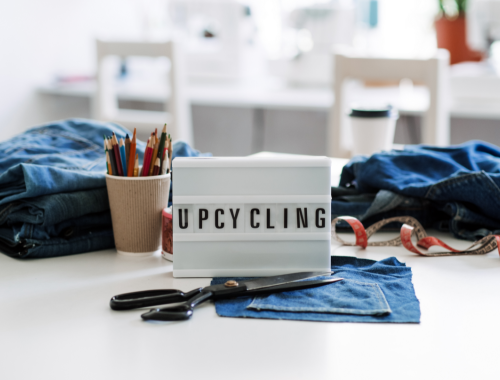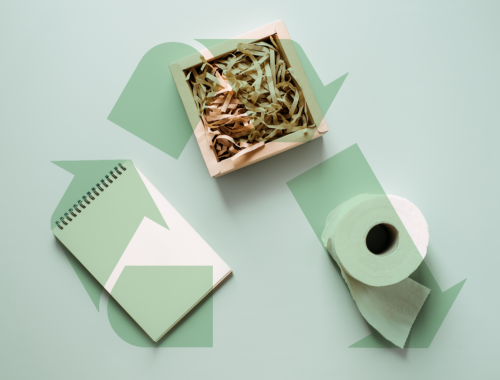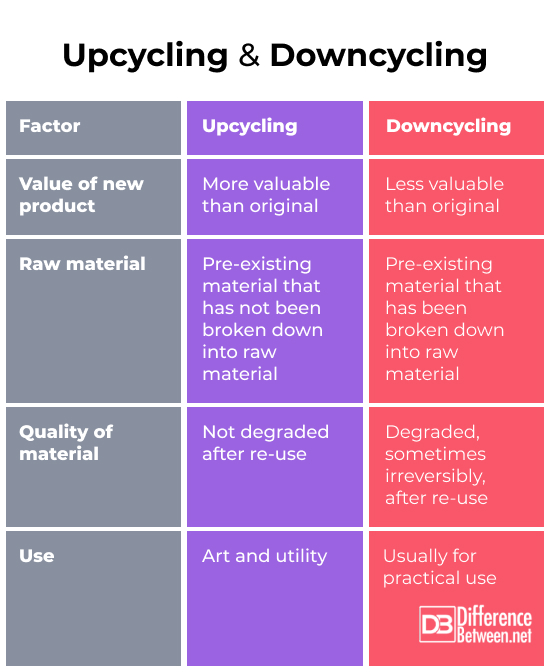Difference Between Upcycling and Downcycling

Upcycling
What is the concept of upcycling?
Upcycling refers to a process by which discarded products or waste materials are re-purposed to create products that are considered more valuable than the original products. Upcycling differs from recycling since the materials are not broken down in the process but are incorporated into the creation of the new product. Upcycling is used both to create items that are for everyday use, such as tables or containers, and to create new works of art. Upcycling is one way to reduce the amount of trash produced by human civilization through re-using items or materials that are no longer fulfilling their original function rather than simply discarding them.
What is considered upcycled?
Any manufactured item that is re-purposed, without breaking it down to raw materials, so that it is of greater value than it was originally can be said to have been upcycled.
What is an example of upcycling?
An example of upcycling might be a table where the table legs are made out of discarded aluminum cans. Another example might be a tote bag made of plastic pouches that were originally used for containing dishwasher detergent.

Downcycling
Downcycling is the process by which discarded products or materials are broken down to create products that are of lesser value or quality than the original manufactured object or material. Downcycling prevents the material from simply being discarded and ending up in a landfill. Some experts consider all recycling to be downcycling. The two concepts are related. Both involve breaking down discarded products into their raw materials in order to reconstitute them as useful products. Downcycling can be contrasted with recycling in that recycling does not necessarily involve creating a product that is of lesser value than the original manufactured object. Certain types of materials can be recycled without being downcycled. These include materials such as aluminum and glass. Other materials, such as plastics, will degrade further each time their structure is broken down for recycling. Thus, some forms of recycling will always be downcycling or become downcycling at some point.
What is an example of downcycling?
A prominent example of downcycling would be breaking down plastic bottles to make them into fleece or polyester. The plastic composing these products will be of an inferior strength and quality to the plastic in the original water bottles. As result, fleece or polyester cannot be broken down again and remade as easily as water bottles. For this reason, the plastic in fleece and polyester is less recyclable than the plastic in plastic bottles. Plastic bottles must eventually be downcycled if they are to be recycled since the plastic can only be re-used a few times before it is too degraded to be re-used to make plastic bottles.
Similarities between upcycling and downcycling
Upcycling and downcycling are similar in that they are both introduced as measures to reduce the amount of refuse produced by human civilization. The amount of trash prevalent in the environment is becoming an increasing concern, especially plastic. This is because plastic takes a long time to degrade and will build up in the environment. An example of this problem is the Great Pacific Garbage Patch where ocean currents have caused enormous amounts of plastic and other trash to be collected in specific areas. The buildup of trash, especially plastic trash, has had an adverse effect on ecosystems and human societies. For example, many marine mammals have drowned from being caught in discarded plastic fishing nets. Also, seabirds will mistake plastic pellets for food and feed them to their offspring, causing them to either starve or have their stomachs rupture. Microplastics have also gotten into the water supply so that most humans consume a certain amount of plastic per-day. For this reason, there are efforts in industry and art movements to re-use waste materials so that the further buildup of trash in the environment and water supply can be prevented. Upcycling and downcycling are both ways to do this.
Differences between upcycling and downcycling
Although there are similarities between upcycling and downcycling, there are also important differences. These differences include the following.
- Upcycling involves creating products of greater value than the pre-existing product, whereas downcycling creates products of lesser value.
- Upcycling involves using materials from pre-existing products which have not been broken down or reconstituted, whereas downcycling requires breaking down pre-existing materials first.
- Upcycling can involve the use of any material, whereas some materials will degrade over time when being broken down into raw materials and reconstituted, making them useless for downcycling.
- Upcycling is more popular among artists, whereas downcycling is usually used to make utilitarian items such as clothing or lumber products.
What are the differences between upcycled art and downcycled art?
Upcycled art would be art where items or materials have been directly repurposed in order to create an artwork. For example, cardboard might be used as the canvass for a painting without breaking down the original cardboard. Downcycled art would be art made of material that has already been broken down structurally and reconstituted as an inferior product.
Why is upcycling better than downcycling?
The advantage of upcycling is that the original product or material is not completely destroyed or degraded in the process of upcycling, meaning that fewer things will ultimately have to be thrown away. Downcycling, on the other hand, involves the continuous breakdown of materials and products. Some materials and products degrade in quality after being broken down into raw materials, meaning that certain materials, such as plastics, will eventually no longer be useful and end up as trash even if they are recycled or downcycled at first.
Upcycling vs. downcycling

Summary
Upcycling involves taking pre-existing materials and products which have lost their original function and making them into something more valuable than the original manufactured items or material. Upcycling differs from recycling in that the material composing the product is not broken down to raw materials before re-use. Upcycling is often used in art as well as practical items. Downcycling involves taking pre-existing materials and products that have lost their original function and making them into products of lesser value than the pre-existing products or materials. Downcycling differs from recycling in that recycling does not necessarily involve creating a product of lesser value. For some materials, such as plastic, recycling will always involve downcycling because plastics degrade in their usability every time they are broken down into raw materials for re-use. Downcycling and upcycling are similar in that both are ways to reduce the amount of refuse being produced by civilization and considered more environmentally responsible than simply throwing away things. They differ in important ways as well. Upcycled products will be more valuable than the originals, made of pre-existing material or products that have not been broken down first, and often have artistic value as well as practical value. Downcycled products, on the other hand, will be less valuable than the original, will be composed of materials that have been broken down and, in some cases, irreversibly degraded in the process of downcycling, and will be less likely to have perceived artistic value.
- Difference Between Environmental Performance Index and Development - November 24, 2023
- Difference Between Environmental Intervention and Development - November 8, 2023
- Difference Between Eco Efficiency and Eco Effectiveness - September 18, 2023
Search DifferenceBetween.net :
Leave a Response
References :
[0]“About Upcycling.” Upcycle that, n.d., https://www.upcyclethat.com/about-upcycling/.
[1]“ART AND UPCYCLING.” Clic Recycle, n.d., https://www.clicrecycle.net/en/art-and-upcycled/.
[2]Edward. “What is the Downcycling Process of Plastic?” O.Berk, https://www.oberk.com/packaging-crash-course/downcycling-temp#:~:text=Downcycling%20is%20the%20term%20used,of%20product%20than%20the%20original. Accessed 20 May 2023.
[3]“Great Pacific Garbage Patch.” National Geographic, 8 May 2023, https://education.nationalgeographic.org/resource/great-pacific-garbage-patch/.
[4]Krosofsky, Andrew. What Is Downcycling?” Greenmatters, https://www.greenmatters.com/p/what-is-downcycling. Accessed 20 May 2023.
[5]“Recycled Art, a form of Environmental Activism.” Watson & Wolfe, n.d., https://www.watsonwolfe.com/2021/01/04/recycled-art-a-form-of-environmental-activism/.
[6]Sulpizio, Jodi. “Microplastics in Our Waters, an Unquestionable Concern.” Penn State Extension, 26 August 2022, https://extension.psu.edu/microplastics-in-our-waters-an-unquestionable-concern.
[7]“What is Downcycling?” Busch Systems Resource Center, n.d., https://www.buschsystems.com/resource-center/knowledgeBase/glossary/what-is-downcycling.
[8]“What is Upcycling?” Habitat for Humanity, n.d., https://www.habitat.org/stories/what-is-upcycling.
